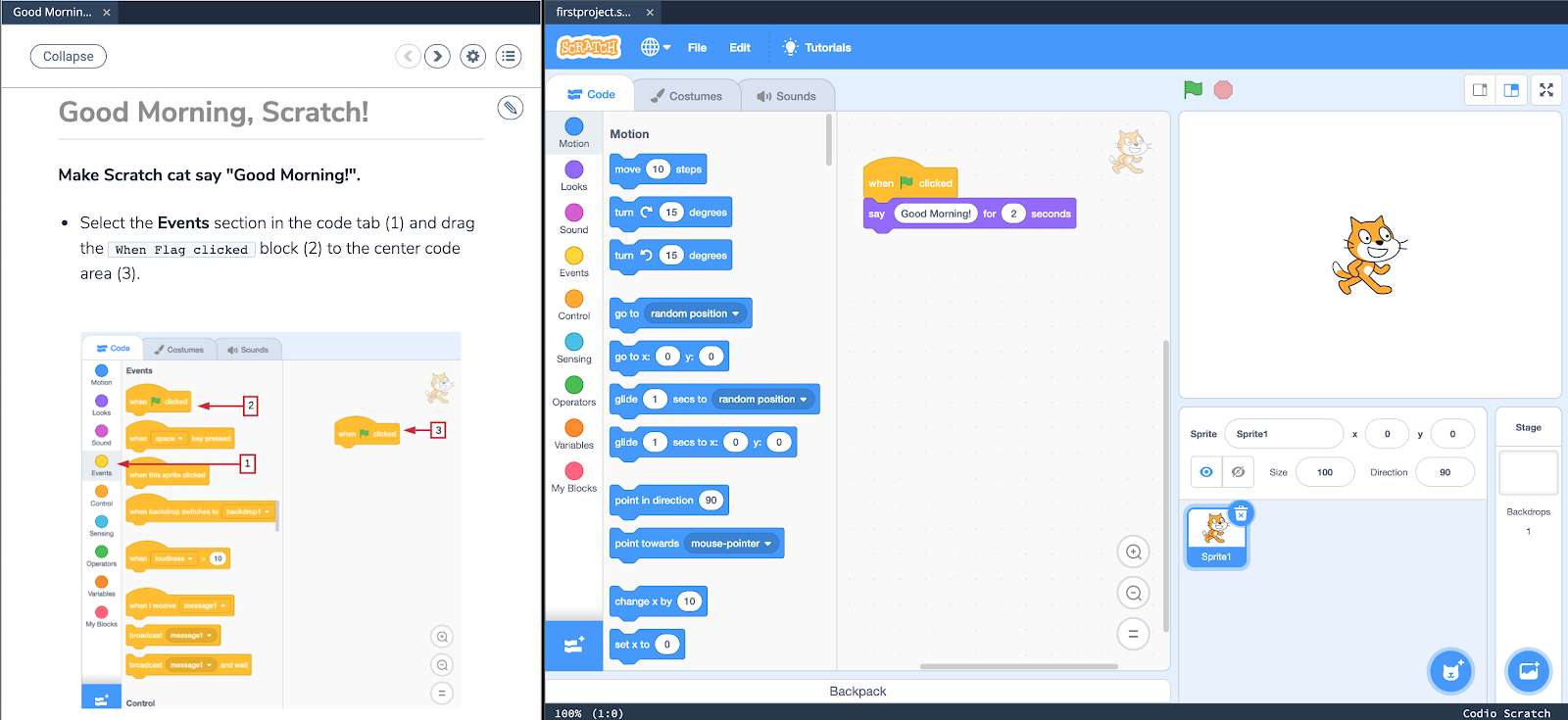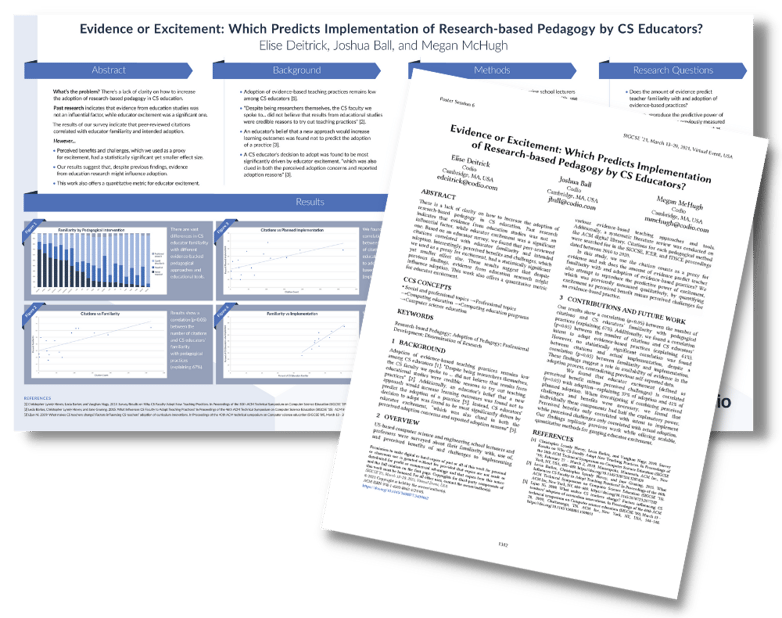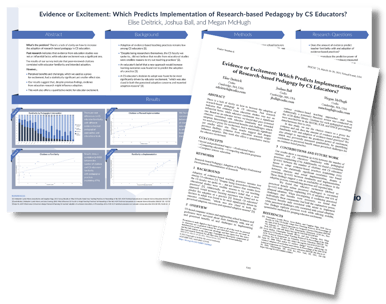From Monday, March 13th through Saturday, March 20th the Codio team spent time participating in and attending SIGCSE’s Technical Symposium. SIGCSE is the Special Interest Group for Computer Science Education and the Technical Symposium is its flagship conference.
“The SIGCSE Technical Symposium addresses problems common among educators working to develop, implement and/or evaluate computing programs, curricula, and courses. The symposium provides a forum for sharing new ideas for syllabi, laboratories, and other elements of teaching and pedagogy, at all levels of instruction. The symposium provides a diverse selection of technical sessions and opportunities for learning and interaction.” [1]
We were fortunate enough to host a SIGCSE supporter session, demonstration, and poster presentation, which you can have access to! Our education team also attended panel discussions, paper presentations, and demonstrations all week. Now, they want to share their thoughts with you! Each section below will feature unfiltered opinions and feedback on the hottest topics from SIGCSE 2021.
Codio’s Contributions
Elise Deitrick, PhD, hosted a session titled “Pedagogical Practices in U.S. Colleges and Universities” which you can view on-demand here. In this session, Elise outlines findings from our 2020 Survey of Computer Science Teaching Report, which focused on discovering what research-based pedagogies CS educators are adopting—or not adopting— and why.
You can also view our peer-reviewed abstract and poster, “Evidence or Excitement: Which Predicts Implementation of Research-based Pedagogy by CS Educators?” by Elise Deitrick, Joshua Ball, and myself. Feel free to download the research poster and abstract here and share with colleagues!
Elise Deitrick, Vice President of Product & Partnerships
I spent SIGCSE in a lot fewer paper sessions than normal due to the updated format which made me feel like I had to watch the 20 minute videos to fully engage with the authors. Due to this, I wound up in some really great panels, BOFs and demos which loosely themed around access. If you want the particular sessions - they include the panel on free textbooks or TextbooksForAll, the CS-Ed podcast panel on elimination inequities, and the demo session I presented in.
It was striking to me how many dimensions of access were described between these various sessions:
- Access to materials
- Accessible technology
- Access to ideas in courses
Access to Materials
In increasingly challenging order to discuss and dissect -- let’s start with access to materials. The TextbooksForAll panel discussed why community members were writing free textbooks. This ranged from not liking what was in the market because students aren’t going to read dozens of pages a week, to getting feedback from students that the required text was too expensive, to there being no books written at the appropriate level for the students they were teaching. Two of the authors remarked that their textbook was easily the most read artifact they had written. Authoring a free, digital textbook comes with a lot of upsides to this level of community engagement -- including reviews of the content from trusted community members to ample feedback allowing the text to quickly get refined.
Accessible Technology
In terms of accessible technology, we not only were in a platform that attempted to be accessible (being thrown out of meetings when accidentally missing the little X on the points notification drove me nuts), but there were a number of researcher created technologies shown throughout demos and even paper sessions. Unfortunately, with the exception of the Berkley team’s Snap! HyperBlocks demo, most researchers hadn't even considered nor implemented any accessibility features.
The University of Alabama’s poster really calls out that if you want to create accessible tools, often you need to build them with accessibility in mind. We see a lot of wonderful tools come out of CS Education research which are never audited for, or address, accessibility in their implementation. This includes big names like Scratch and Python Tutor and tools we are still actively building on such as the js-parsons library, which many researchers and tools use under-the-hood to create Parsons problems.

An example of Scratch
How do we do a better job creating tools that can actually be used in an inclusive classroom? Do we need to include budget lines in our grants for extra development time and accessibility auditing services? Should we be putting together a SIGCSE workshop on how to turn your research tool into an accessible technology?
Access to Ideas in Courses
One of my favorite sessions was the CSEd podcast panel which covered a lot of ground on why and how courses are not currently designed to serve all the students in the room. Starting from Nicki Washington’s work on cultural competence, Dr. Washington once again fearlessly names that the educators need to pick up the work -- there is no silver-bullet curriculum you can shove into your class.
“To talk about the technology properly, you need to talk about race and society.” - Dr. Nicki Washington
They also captured the struggle of how we systematize programs to make progress on these issues. Leigh Ann DeLyser asked how do we move beyond needing flag bearers to sustain programs? One suggestion was reaching out from CS programs and creating interdisciplinary work with gender students programs and sociology programs.
When turning to the content itself, Manuel Pérez-Quiñones called out that “not all our graduates are going to be developers.” He challenged faculty to look at the first few courses, it's programming and narrow -- you could do ethics and HCI instead. Why do we still insist we do 3 semesters of programming before we do anything else? There was some amazing responses to the question that built on this, including how to respond to people who claim that increasing equity decreases “rigor”:
@mapq - What do you mean by rigor?@dr_nickiw - Rigor comes up whenever you try to make something inclusive. "White is not right" - just because it wasn't your experience, doesn't make it worse@lsudol CS1 courses were literally designed to exclude -and we haven't reformed them pic.twitter.com/fxwfjfHOsE
— Elise Deitrick (@edeitrick) March 16, 2021
As much as we all hate to hear it, I’m with Leigh Ann DeLyser -- On some level, we need to burn the curriculum down and start again. Courses that weed students out are not serving anyone.
Patrick Ester, Senior Computer Science Curriculum Developer
Bootstrap
Bootstrap is a non-profit organization that develops an integrated curriculum to introduce computer science in other courses. It started with Algebra and has incorporated other topics like physics and data science. The integrated approach to teaching computer science is an idea that is gaining momentum. This paper draws on Bootstrap’s ten years of experience in curriculum development and teacher training for a successful, integrated approach to computer science.
A slide from Kathi Fisler’s SIGCSE presentation
The one characteristic that sets Bootstrap apart is its commitment to meeting teachers where they are. Despite the trend pushing computer science as a fundamental skill, the Bootstrap professional development sessions puts the other subject (often algebra) first. A curriculum is only successful when teachers use it. Algebra teachers are not incentivized to use a curriculum if their class time is spent talking about a subject that is not really relevant to their own. If you support teachers in their goals, enthusiasm for the computer science activities will follow. An integrated approach is more than mandating other subjects adopt computer science activities. Teachers need to see integrated computer science as a reciprocal and beneficial relationship.
View the abstract here: Evolving a K-12 Curriculum for Integrating Computer Science into Mathematics authored - Kathi Fisler et al.
Novice Programming Hints
The University of Florida designed a custom coding environment for novice students. One of the key features of this environment is the ability for students to request a hint when they are stuck coding their solution. The environment has a canonical solution created by a subject matter expert. A regular expression evaluates the student code, compares it to the solution, and offers hints based on the difference between the two. When looking at information about hint requests, the authors found that students tended to fall into five different clusters.
A slide from Joseph Wiggin’s SIGCSE presentation
If the trends of this study hold true on a larger scale, this opens the door for interesting work on automated feedback. The reasons a student feels stuck on a coding problem are varied. As such, automated feedback tends to be comprehensive so the largest number of students find the help they need. This is not ideal. A better solution would be to show only that information which pertains to the student. This is easier said than done. If the five-cluster pattern is true, then this provides a solid foundation for automated feedback better suited to the needs of each student.
View the abstract here: Exploring Novice Programmers' Hint Requests in an Intelligent Block-Based Coding Environment - Joseph B. Wiggins et al.
TIPP&SEE
An unfortunate truth about education in America is that some schools have more resources than others. Students at well-resourced schools tend to outperform students from schools that do not have as many resources. There are many reasons for this which fall outside the scope of this paper. The authors wanted to address this performance gap through pedagogical changes. The paper focuses on elementary students using Scratch. The authors started with the use, modify, create scaffolding and made changes to the use and modify stages. This new methodology is called TIPP&SEE. TIPP stands for Title, Instructions, Purpose, and Play. SEE stands for Sprites, Events, and Explore. TIPP&SEE aims to maximize student learning during the use and modify stages so their creations make better use of the required computer science topics. For examples of TIPP&SEE, see the Act I resources from Canon Lab.
A slide from Jean Salac’s SIGCSE presentation
The results from the study are very encouraging. Economically disadvantaged students using TIPP&SEE perform on par with economically advantaged students not using TIPP&SEE. In fact, the study concludes that the differences between the two are not statistically significant. Digital literacy and computer science are falling victim to performance gaps, and there is considerable worry that students will be ill-prepared for those jobs that require these skills. Digital literacy and Computer Science are often viewed through technology; buy the right technology and then learning can take place. This study shows that it is not necessarily about the technology. The right pedagogy can narrow the performance gap.
View the abstract here: Supporting Diverse Learners in K-8 Computational Thinking with TIPP&SEE - Jean Salac et al.
Interdisciplinary Data Science
University of California Riverside recently started a new Data Science curriculum. A major impetus for this is the rising number of students from outside the College of Engineering who are taking computer science courses. In fact, 75% of enrollment comes from non-engineers. The breakdown of enrollment by gender shows that 86% of the students are male. This trend holds true from 2014 to 2018. The university decided to capitalize on the outside interest in computer science courses and look to increase diversity among enrolled students through a new data science program.
A slide from Mariam Solloum’s SIGCSE presentation
The rollout of the course faced some obstacles, mostly related to COVID. In addition, the program was not advertised in the course catalog. Instead, it was offered to students currently enrolled in computer science, computer engineering, or statistics. Despite this, UC Riverside saw a slight increase in female enrollment. This trend seems to be continuing with 40% of the latest applicants identifying as female. This study is far from conclusive, but the initial results are worth closer investigation. Does this trend continue? What happens when the major is advertised in the course catalog? Are other institutions seeing similar results? More importantly, diversity is not solely defined as male/female. Does the data science program attract diverse students in a holistic sense? The lack of diversity in computer science is well known. This is a problem in both education and industry. Perhaps one part of the solution is to offer data science alongside computer science.
View the abstract here: Developing an Interdisciplinary Data Science Program - Mariam Salloum et al.
Anh Le, Computer Science Curriculum Developer
I would summarize that all of the paper sessions that I attended had one common theme, and that was student success.
Interesting Paper Session Recaps
“Mapping Materials to Curriculum Standards for Design, Alignment, Audit, and Search” introduced an open source tool called “CS Materials” to help teachers align their curriculum with the standards. This can help a lot of teachers who are unsure about their own curriculum.
“Confronting Inequities in Computer Science Education: A Case for Critical Theory” suggests that research that seeks to improve CS in some form, should take into account the populations they are trying to serve. All too often, research focuses on verifying or disproving an issue versus actually confronting the issue. For example: Do block-based programming environments reduce programming misconceptions? versus How are the needs of students with low vision or blindness met in block-based programming courses? We want to shift our focus from the first question to the latter.
“Improving Content Learning and Student Perceptions in CS1 with Scrumage” - Scrumage is the idea that students should have the autonomy to determine for themselves how they want to learn something. Every class session, the students collectively decide the mode in which they will receive instruction from the teacher. If a student does not want to participate in the learning mode chosen, they can choose to not participate and instead engage in another activity. Results showed more improved content learning for Scrumage groups versus the groups that did not have Scrumage.
“Exploring the Digital Identity Divide: A Call for Attention to Computing Identity at HBCUs” suggests courses should be divided into 2 phases to improve the “computing identity” of students. Computing identity is how students perceive themselves in the grand scheme of the computing/tech world. The first phase is a motivational one, where teachers should expose students to the works of people of color. Then transition to phase two where students start crafting and building their assets.
“The Impact of Programming Project Milestones on Procrastination, Project Outcomes, and Course Outcomes: A Quasi-Experimental Study in a Third-Year Data Structures Course” proposes the idea of turning regular academic projects into project milestones where students are expected to complete assignments in many smaller steps. The study shows that students who were in the “milestones” groups tend to complete their assignments on time and completed them more accurately versus the groups who did not have milestones.
“Sustaining Student Engagement and Equity in Computing Departments During the COVID-19 Pandemic” shows that professors, peers, and advisors were the number one resources for students during COVID. Students reported that even just a simple “how are you doing?” at the beginning of class really helped give them a sense of comfort and stability which in turn reduced their anxiety and stress levels.
“A Game-Based Approach for Teaching Algorithms and Data Structures using Visualizations” shows that an overwhelming number of students prefer to “see” what they are learning, which isn’t always an easy task when it comes to CS topics. Some topics are too abstract! However, teachers can play a critical role in bridging this gap by developing other more visual approaches to teaching. This will help increase student engagement and understanding → student success.
The Role of Computer Science Educators
My take-away message is that teachers play a very critical role in CS education. Whether it relates to checking in with students to ask how they’re doing or implementing another approach when it comes to teaching difficult topics, teachers are the bridge that connects students to success. Unfortunately, most higher education institutions have a tight budget for professional development, which means the teachers themselves have to find the time and funding to implement some of these interventions. Perhaps, there needs to be something in place to hold institutions more accountable for the support they offer teachers.
Kevin Noelsaint, Computer Science Curriculum Developer
After spending a week hearing from CS ed researchers, not only have I discovered problems facing students and learners, but I have a few unanswered questions, as well.
Birds of a Feather
One particularly interesting session at SIGCSE was the Birds of a Feather (BOF) - “Using Validated Assessments to Learn About Your Students”. This session discussed how instructors and researchers can better understand instruments used for education research or comparing student learning across terms, as well as tools that help you better understand student misconceptions. This particular session posed many great questions such as :
- How can assessments support equity?
- Can we design different culturally-relevant problems on assessments?
- How can we empower teachers to make assessments that are useful for them?
In a lot of the BOF talks that I attended, there was discussion of what seems to be a low retention rate of students. One thing that came up was the high stress level of intro CS courses. Starting off there is already the stigma that computer science is going to be hard. Comparatively, CS education is not harder than other subjects, but rather very different for students in the way they tackle problems. One possible solution? Removing letter grades for quizzes and low stake assessments to create a space just for learning. This allows you to help build a comfortable environment where students can gain confidence in their computer science abilities.
After the discussion, I thought that one way to target the assessment challenge could be with frequent, low-stakes quizzes. For one, repetition of quizzes enables students to become more comfortable with them and remove some of the anxiety that comes with taking assessments. Secondly, they allow instructors to do a quick check-in about the material and students’ comprehension. We practice this at Codio by featuring a formative assessment at the end of each page in our in-house curriculum content. We can take this solution a step further by giving students the opportunity to fix their mistakes on quizzes. This way it's more of a learning experience because the student can't just slide the quiz under the table. In essence, this will help clear misconceptions before they take root.
Questions on the State of CS Education
After attending SIGCSE, I find myself with questions including:
- When it comes to teaching software engineering, what language is most difficult for students to learn?
- For programming beginners, which language is most helpful or easily digestible and should be focused on first? Python, Java, C, or something else? What makes these languages beneficial for beginners?
- What are ways to help students learn better self-regulation of learning skills in relation to CS education?
All in all, SIGCSE was a fantastic experience for everyone on the Codio team. We look forward to a future where we can meet with other CS educators face-to-face at the symposium!
Resources
[1] Association of Computing Machinery. SIGCSE Technical Symposium. SIGCSE. https://sigcse.org/sigcse/events/symposia/index.html


